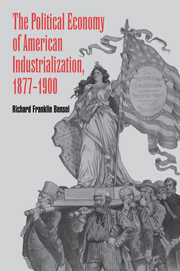Book contents
- Frontmatter
- Contents
- List of Tables
- List of Maps and Charts
- Preface
- Chapter 1 Introduction
- Chapter 2 Uneven Economic Development in the United States
- Chapter 3 Platform Demands, Party Competition, and Industrialization
- Chapter 4 Claims on Wealth and Electoral Coalitions
- Chapter 5 Political Construction of the National Market
- Chapter 6 Political Administration and Defense of the Gold Standard
- Chapter 7 Tariff Protection and the Republican Party
- Chapter 8 Conclusion
- Index
Chapter 7 - Tariff Protection and the Republican Party
Published online by Cambridge University Press: 27 March 2010
- Frontmatter
- Contents
- List of Tables
- List of Maps and Charts
- Preface
- Chapter 1 Introduction
- Chapter 2 Uneven Economic Development in the United States
- Chapter 3 Platform Demands, Party Competition, and Industrialization
- Chapter 4 Claims on Wealth and Electoral Coalitions
- Chapter 5 Political Construction of the National Market
- Chapter 6 Political Administration and Defense of the Gold Standard
- Chapter 7 Tariff Protection and the Republican Party
- Chapter 8 Conclusion
- Index
Summary
Standing at the very center of the Republican coalition that guided late nineteenth-century industrialization, the tariff most immediately benefited industrial manufacturers who were directly exposed to foreign competition. But the benefit conferred on these producers was not enough to politically sustain the tariff. For that reason, the tariff coalition was broadened by protecting selected agricultural products as well. Because the United States exported vast amounts of grain, cotton, and other agricultural products, the list of farm goods that could be enlisted into the tariff coalition was a short one, with raw wool at the head. Sugar, which enjoyed a domestic market robust enough to withstand very high duties on imports, generated much of the revenue from the tariff and, incidentally, often attracted Louisiana congressmen to the coalition.
The revenue generated from protection, in turn, supported a vast pension system for Union veterans who, through the Grand Army of the Republic, subsequently enlisted in the tariff coalition. Further underpinning Republican dominance within the manufacturing belt, the combination of protection and pensions gave American industrialization a particularly nationalist flavor. In addition, by extending the tariff coalition into the western plains, the pension system probably postponed and ultimately weakened western revolt against the “gold and protection” developmental path followed by the United States. “Voting as they had shot,” Union veterans refought the Civil War, this time as a conflict over pension benefits and northern industrialization.
- Type
- Chapter
- Information
- The Political Economy of American Industrialization, 1877–1900 , pp. 457 - 509Publisher: Cambridge University PressPrint publication year: 2000
- 2
- Cited by



